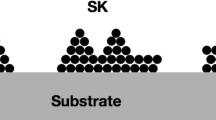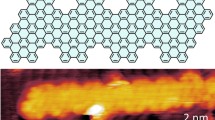Abstract
Gold nanowire chains are considered a good candidate for nanoelectronic devices because they exhibit remarkable structural and electrical properties. A previous study shows that the beryllium-terminated BeO (0001) surface may be a useful platform for supporting nano gold conductors, since it preserves the nano-wire configuration, does not restrict its conductivity, and even enhances it. However, the influence of contamination on the conductivity of such conductors is unknown. Here, ab initio simulations were performed to determine the effect of commonly adsorbed contaminants (H2O and O2) on the conductivity of gold nano-conductors. We found that the presence of adsorbed impurities does not alter the good conductive ability of the conductors under examination.




Similar content being viewed by others
Notes
Commercial software is identified to specify procedures. Such identification does not imply recommendation by the National Institute of Standards and Technology.
References
Schulz M (1999) Nature 399:729
Lundstrom M (2003) Science 299:210
Leong M, Doris B, Kedzierski J, Rim K, Yang M (2004) Science 306:2057
Yanson IK, Shklyarevskii OI, Csonka S, van Kempen H, Speller S, Yanso AI, van Ruitenbeek JM (2005) Phys Rev Lett 95:256806
Kiguchi M, Konishi T, Murakoshi K (2006) Phys Rev B 73:125406
Suzuki R, Tsutsui M, Miura D, Kurokawa S, Sakai A (2007) Jpn J Appl Phys 46:3694
Kizuka T (2008) Phys Rev B 77:155401
Oshima Y, Kurui Y, Takayanagi K (2010) J Phys Soc Jpn 79:054702
Scheer E et al (1998) Nature 394:154
Kurui Y, Oshima Y, Okamoto M, Takayanagi K (2009) Phys Rev B 79:165414
Smit RHM, Untiedt C, Rubio-Bollinger G, Segers RC, van Ruitenbeek JM (2003) Phys Rev Lett 91:076805
Dreher M, Pauly F, Heurich J, Cuevas JC, Scheer E, Nielaba P (2005) Phys Rev B 72:75435
Ohnishi H, Kondo Y, Takayanagi K (1998) Nature 395:780
Tavazza F, Levine LE, Chaka AM (2009) J Appl Phys 106:43522
Agraıt N, Yeyati AL, van Ruitenbeek JM (2003) Phys Rep 377:81
Agraıt N, Rubio G, Vieira S (1995) Phys Rev Lett 74:3995
Rubio-Bollinger G, Joyez P, Agraıt N (2004) Phys Rev Lett 93:11680
Nitzan A, Ratner MA (2003) Science 300:1384
Qian Z, Li R, Hou S, Xue Z, Sanvito S (2007) J Chem Phys 127:194710
Brandbyge M, Mozoz JL, Ordejon P, Taylor J, Stokbro K (2002) Phys Rev B 65:165401
Fujimoto Y, Hirose K (2003) Phys Rev B 67:195315
Lee YJ et al (2004) Phys Rev B 69:125409
Zhuang M, Ernzerhof M (2004) J Chem Phys 120:4921
Barzilai S, Tavazza F, Levine LE (2013) Model Simul Mater Sci Eng 21:25004
Ke L et al (2007) Nanotechnology 18:095709
Grigoriev A, Skorodumova NV, Simak SI, Wendin G, Johansson B, Ahuja R (2006) Phys Rev Lett 97:236807
Tavazza F, Levine LE, Chaka AM (2010) Phys Rev B 81:235424
Nilius N, Wallis TM, Ho M (2002) Science 297:1853
Nilius N, Wallis TM, Ho M (2005) Appl Phys Rev A 80:951
Nilius N, Wallis TM, Persson M, Ho M (2003) Phys Rev Lett 90:196103
Calzolari A, Cavazzoni C, Nardelli MB (2004) Phys Rev Lett 93:96404
Sashin VA, Bolorizadeh MA, Kheifets AS, Ford MJ (2003) J Phys Condens Matter 15:3567
Slack GA (1973) J Phys Chem Solids 34:321
Barzilai S, Tavazza F, Levine LE (2013) Surf Sci 609:39
Barzilai S, Tavazza F, Levine L (2013) Model Simul Mater Sci (in review)
Delley B (1990) J Chem Phys 92:508
Delley B (2000) J Chem Phys 113:7756
Perdew JP, Burke S, Ernzerhof M (1996) Phys Rev Lett 77:3865
Delley B (2002) Phys Rev B 66:155125
Pulay P, Fogarasi G (1992) J Chem Phys 96:2856
Baker J, Kessi A, Delley B (1996) J Chem Phys 5:192
Datta S (1995) Electron transport in mesoscopic systems. Cambridge University Press, Cambridge, MA
Perdew JP, Zunger A (1981) Phys Rev B 23:5048
Soler JM, Artacho E, Gale JD, Garc’ia A, Junquera J, Ordej’on P, S’anchez D (2002) J Phys Condens Mater 14:2745
Atomistix ToolKit (2012) version 12.02, QuantumWise A/S
Taylor J, Guo H, Wang J (2001) Phys Rev B 63:245407
Author information
Authors and Affiliations
Corresponding author
Additional information
S. Barzilai is on sabbatical leave from the Nuclear Research Center NEGEV.
Rights and permissions
About this article
Cite this article
Barzilai, S., Tavazza, F. & Levine, L.E. Sensitivity of gold nano-conductors to common contaminations: ab initio results. J Mater Sci 48, 6619–6624 (2013). https://doi.org/10.1007/s10853-013-7460-0
Received:
Accepted:
Published:
Issue Date:
DOI: https://doi.org/10.1007/s10853-013-7460-0




